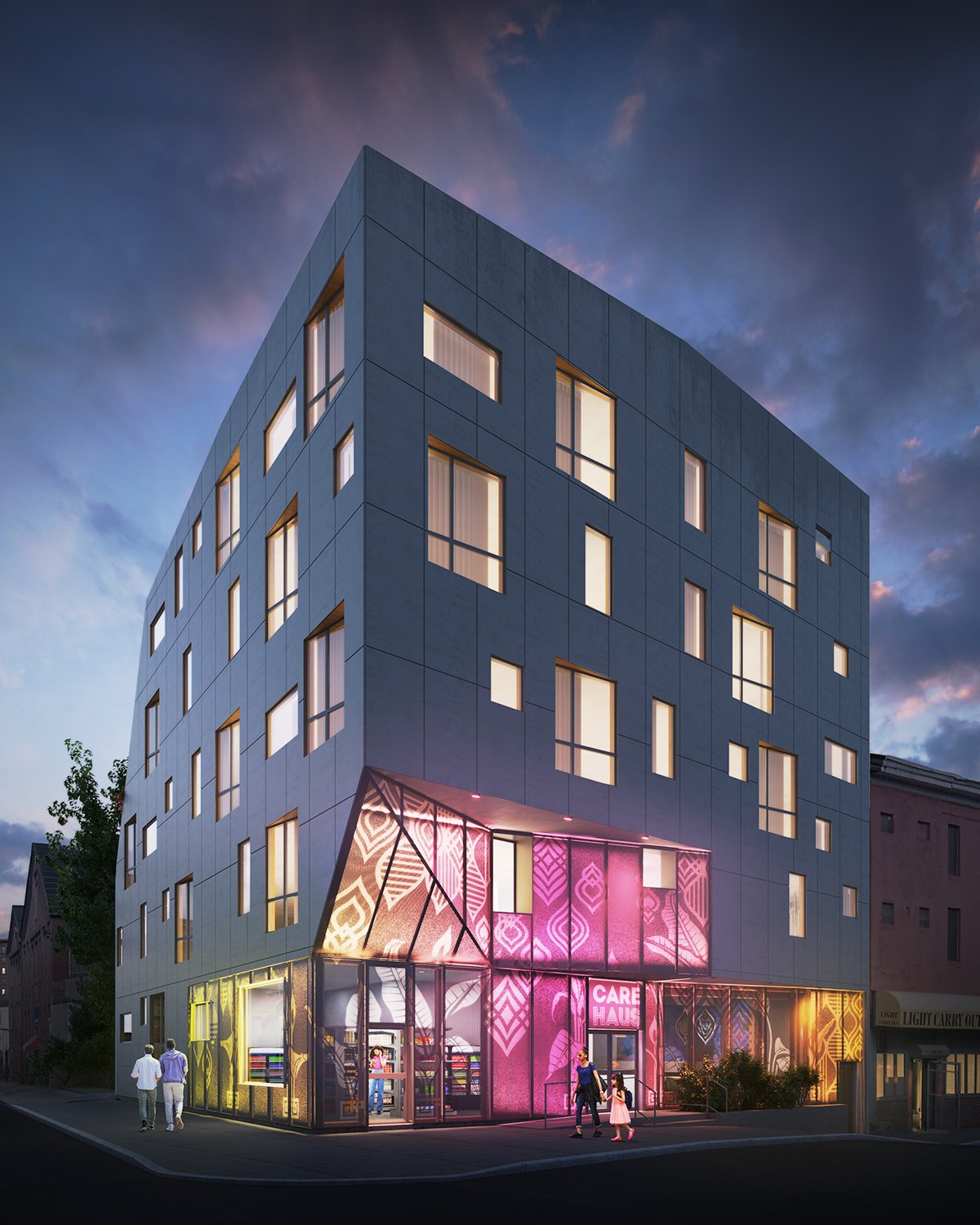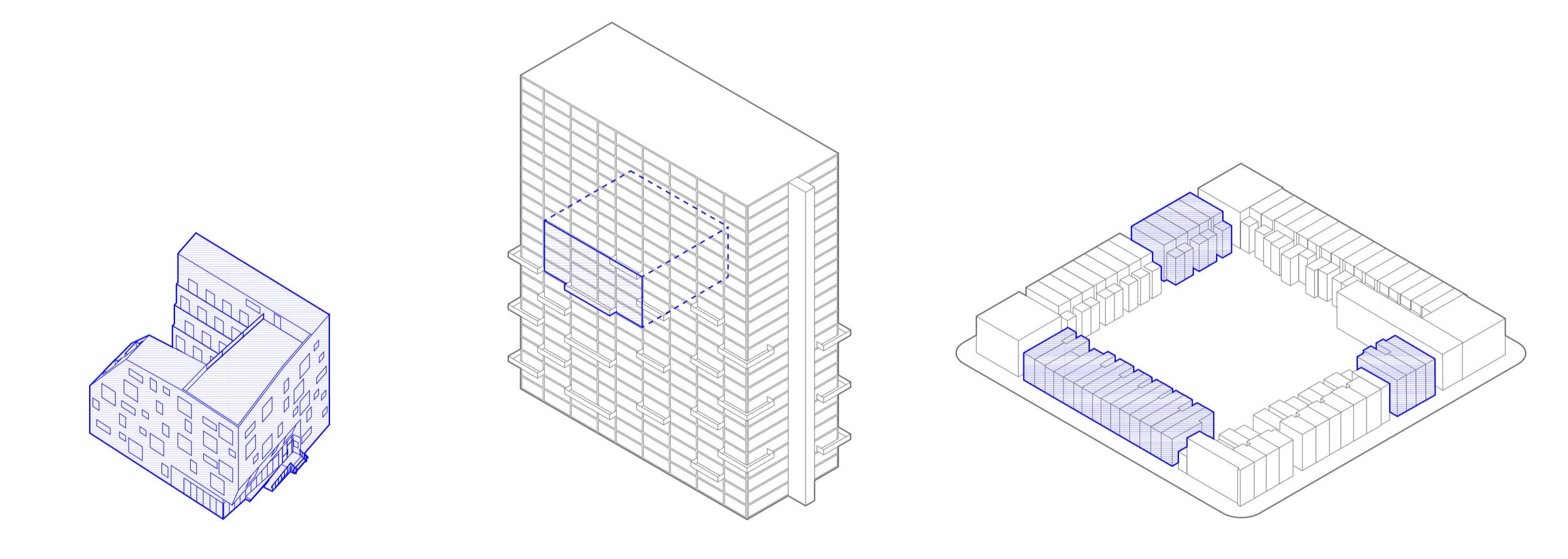The U.S.’s first intergenerational care-based co-housing project.
Mission: Carehaus is an innovative yet simple concept that combines:
Developmentally-appropriate homes and consistent, quality care for older adults
Quality jobs and homes for caregivers
Social integration for multigenerational residents
Sustainable, economic and cultural revitalization for surrounding neighborhood
Aiming to help address the U.S.' care and housing crisis, Carehaus' design and business structure is replicable and responds to each neighborhood's unique conditions.
How it works: In a Carehaus, older adults, caregivers and their families live in independent living units clustered around shared spaces. In exchange for their labor, caregivers receive good wages, childcare, and various benefits. An additional team engages residents in shared meals, horticulture, art, fitness, physical therapy, financial literacy courses, and more.
Our first site, Carehaus Baltimore, has 21 units. Architecture: Rafi Segal A+U, 2020. Facade designed in collaboration with Marisa Morán Jahn.

Carehaus’ strategy of development without displacement in historically divested neighborhoods strengthens its surrounding community:
Neighborhood anchor and community space
Thriving mixed-use residential and retail spaces
Job training, workforce development, and two-way mentorship for olders and youngers
Freeing up adult children and family caregivers to pursue their careers and education
Densifying neighborhoods with safe, livable homes, increasing housing stock and homeownership, and passing on generational wealth

Aequo: [Latin] to make level, equal; root word of the word equity.
Carehaus is an initiative of Aequo Foundation, a 501(3)(c) non-profit committed to providing affordable and workforce housing, both homeownership and rental units.
Aequo Foundation works to level the field in the real estate industry, allowing developers of color or of other non-traditional backgrounds to shape how, where and for whom development occurs in their communities. The foundation also partners with universities to provide non-traditional developers seeking high level graduate level real estate training.
Designed to Scale:
Carehaus can be designed as a standalone building, integrated within a tower, or scaled across a neighborhood.
Development without displacement: Carehaus activates a corner in Johnston Square, a historically-divested neighborhood in Central Baltimore.
Drawing by Rafi Segal A+U, 2020
Carehaus is founded on the belief that older adults and those who care for them are integral to the well-being of our communities.
Yet as a society, we have yet not begun to design for the increasing number of aging, disabled, or visually impaired people in our neighborhoods — nor design for those who care for them.
Through accessible architecture/design and programming, Carehaus enables residents to fully participate in a democratic society.
Designs for care and living: Carehaus’ communal areas (designated by pink spaces) enable shared meals, past times, relaxation, gardening, art and fitness classes, and more.
Drawing by Rafi Segal A+U, 2020
Carehaus is founded on the belief that dignified care should be accessible to anyone who needs it.
Challenge: Long-term care is financially out of reach for 90% of older adults in the U.S. At the same time, there are simply not enough caregivers to meet the existing needs of older and disabled adults. Care gaps lead to to poor nutrition, missed medication, and costly, preventable late-stage hospital admissions.
Solution: Carehaus designs for “congregate care” or “care-sharing” which makes caregiving more efficient and safer: caregivers can take turns keeping an eye on those who need close monitoring or support each other in tasks such as leaning over to lift heavier residents.
Pandemic-friendly architecture: Various features (outdoor gardens and terraces for socializing, no narrow corridors, drop off locations for packages) anticipate the needs of a pandemic.
Drawing by Rafi Segal A+U, 2020
Carehaus is founded on the belief that caregivers’ stability directly impacts the health of older and disabled people in times of regular illnesses and in crises.
Challenge: In the United States, caregiving is an industry characterized by low wages and high turnover. 60% of caregivers in the United States face food insecurity and housing instability.
Solution: Carehaus provides caregivers with good wages, benefits, childcare, and housing designed to balance their need for privacy with shared amenities. By providing good jobs and reducing turnover, Carehaus passes these cost-savings on in terms of affordable care for older and disabled residents.
Arts and Local Histories: In Carehaus Baltimore, floor to ceiling wallpaper in the common areas celebrates an under-chronicled period of cultural efflorescence and civic leadership starting in the 1960s through 1970s led low-income families. These achievements include pre-natal clinics in public housing, the city’s first Black fire department, expanded education programs, and multigenerational cultural recreation programs.
Collage and monoprint images above: Re/Creation by Marisa Morán Jahn in collaboration with Micah Campbell Smith and Dr. Sarah Szanton, 2024. Photos permission by the Robert Breckman Chapman Archive at the University of Baltimore. Images courtesy of Sapar Contemporary.
Carehaus is founded on the belief that the arts play a critical role in promoting dialogue, cultural esteem, and shifting how we value care.
Challenge: To reverse decades of cultural and economic disinvestment in minoritized communities and the wellbeing older adults, society needs art, architecture, and design to help lead this shift.
Solution: Art, architecture, and designs at each Carehaus will reflect its unique environment — neighborhood, community, history — and provide opportunities for residents and visitors to reflect and engage with each other.
Study for mural by Marisa Morán Jahn, 2020.
Clarisse Castor (above) was a Haitian-American working mother whose generosity anchored the immigrant community around her and enabled others to thrive. Inspired by Clarisse, one floor of Carehaus Baltimore’ interior wallpaper features motifs of a tulip (symbol of love) and lioness (symbol of family cohesion).
Our story: Inspired by social movement leader Ai-jen Poo’s early writing about care and housing and her own family’s struggles with care, artist and care advocate Marisa Morán Jahn wondered what it would look like if our cities centered and celebrated care. “We typically see the most beautiful architecture reserved for museums, hotels, and cultural centers — but how might architecture help inspire a shift in how we value care?” She turned to architect and MIT professor Rafi Segal, to collaborate. Soon after, they teamed up with real estate developer and social entrepreneur Ernst Valery.
Team
Marisa Morán Jahn
Co-Founder
Of Ecuadorian and Chinese descent, artist Marisa Morán Jahn has collaborated with the National Domestic Workers Alliance since 2011 to create “one of 5 apps to change the world” (CNN), two mobile studios (NannyVan, CareForce One), artwork, policy toolkits, and a PBS film. These works have reached 25,000 individuals on the ground and millions more through media (NY Times, BBC, Univision) and presentations at The White House, The United Nations, Tribeca Film Festival, The Guggenheim, and Brooklyn Museum. Jahn is grantee of Creative Capital, Sundance, and Rockefeller Foundation and the Director of Integrated Design at Parsons/The New School. She previously taught at Columbia University and MIT where she continues as a Senior Researcher. Instagram
Rafi Segal
Co-Founder
Rafi Segal is an architect, Associate Professor of Architecture and Urbanism at MIT, and the director of Future Urban Collectives whose work explores how emerging notions of sharing and collectivity can impact the design of buildings and cities. Segal has undertaken large scale urban plans among them a regional plan to address future flooding and sea level rise in the New York metropolitan area, a peace museum and library in Uganda, and communal neighborhoods in Israel, Rwanda, and the Philippines. Segal’s work has been exhibited at venues including the Venice Biennale of Architecture; Museum of Modern Art; and the Hong Kong/Shenzhen Urbanism Biennale. He holds a PhD from Princeton University and a M.Sc and B.Arch from Technion- Israel Institute of Technology. Instagram
Ernst Valery
Co-Founder
A Haitian-American immigrant, Ernst Valery is the founder and president of SAA | EVI affiliate Ernst Valery Investments Corp. (EVI), a minority-owned real estate investment firm that invests in select underserved and undervalued key emerging urban transitional areas with high residential and retail demand. Valery also actively engages in social entrepreneurship. Valery received a MS in Real Estate Development from Columbia University; a MS in Policy Analysis and Public Administration and BS in Urban and Regional Planning from Cornell University. Ernst is a MLK Community Fellow at MIT’s CoLab.
-

Chip Roth
Strategic Partner
Chip Roth was appointed by President Obama to a leadership role in the Small Business Administration, where he developed excellent relationships across the finance community. Thus, he continues to facilitate financing. Prior to this role, he advised VF Corporation, the world’s largest clothes-maker at the time, in realigning its supply chain to take more responsibility for the communities in the 52 countries where it sourced product. As such, Chip was part of bringing health care, education and nutrition to some of the poorest communities in the world. Previously, Chip served as a lead negotiator on multi-billion dollar labor contracts across America. He is an honors graduate of the University of Pittsburgh, which he attended on a full academic scholarship.
-

Denise Turner Roth
Strategic Advisor
Denise Turner Roth reported directly to President Obama as the head of the General Services Administration where she managed 13,000 employees and had $155 billion flow through the accounts that she oversaw each year. Then she served as President of Advisory Services for WSP, the world’s premier infrastructure engineering firm. In this role she led 500 industry leading professionals, advising C-Suite executives on infrastructure planning and policy. Prior to these roles, she served as City Manager of Greensboro, NC. Now, as a consultant, she is advising Harvard’s Kennedy School of Government, Accelerator for America and North Carolina A&T University, the nation’s largest HBCU.
Advisors
Sunny Bates, Co-founder, Kickstarter; Board Member, TED
Caitlin Casperson, Independent Advisor
Sharon Chang, Guild of Future Architects
Thomas K.M. Cudjoe, Geriatric Medicine and Gerontology, Johns Hopkins University
Nathan Elbogen, XO Projects
Marisa Mazria Katz, Journalist
Colleen Keegan, TED Talks, Creative Capital
Ellen Lupton, Maryland Institute College of Art, Cooper-Hewitt Smithsonian Design Museum
Ari Medoff, Partner, Arosacare
Emmanuel Opati, Xpert Care Telemedicine
Ai-jen Poo, National Domestic Workers Alliance; Caring Across Generations
Amy Rosenblum-Martín, Independent Curator
Bonnie Swenor, Johns Hopkins; Disability Health Research Center
Sarah Szanton, Johns Hopkins; Center on Innovative Care in Aging
Jen Van Der Meer, Business Model Designer; CEO, Reason Street; professor, Parsons School of Design
Partners, Collaborators
Baltimore Museum of Art
BrightFocus
Debevoise & Plimpton, LLC
Caring Across Generations
Johns Hopkins
Natl Alliance of Caregivers
Natl Domestic Workers Alliance
Northeastern University School of Law
Paraprofessional Healthcare Institute (PHI)
Open Works
Additional Team
Design Team: Ous Abou Ras, Alina Nazmeeva, Marisa Concetta Waddle, Paul Gruber
Research & Development: Ana Arenas, Adiel Alexis Bénitez, Laura Cadena, Sarah Rege, Noa Machover, Ned Ohringer, Ixchel Ramirez, Luis Alberto Meouchi Velez, Meghan Timmons, Nina Huttemann, Vaidehi Supatkar
Press
“[Carehaus’] care-based, intergenerational cohousing concept is creating buzz.” Sally Abrahms, “Introducing a New Kind of Intergenerational, Care-Based Cohousing.” AARP, April 10, 2024.
“Someday people who need assistance might choose to live in something like Carehaus, a residence where the elderly and their caregivers live together.”
Bryce Covert. “Imagining a better way to grow old in America,”The Nation. July 26, 2021.
“[Carehaus’] project leaders want to center what society too often makes invisible: aging adults and those who care for them.”
Carly Stern. “Caregivers are burned out and underpaid. A new housing model aims to make their work more visible.” Big If True, May 2, 2022.
“[Carehaus] directly addresses the question of exchange of labour in the kitchen.”
Marianna Janowicz. “Kitchen debate: where labour and leisure collide.” Architectural Review. January 6, 2022.
The making of Carehaus is featured in a half-hour documentary film series entitled “Where We Grow Older” conceived by Canadian Centre For Architecture (CCA)’s Director Giovanna Borasi, directed by Daniel Schwartz, and produced by the CCA. World Premiere at Lisbon Architecture Film Festival, 2023 with subsequent screenings internationally.
Publications
“A simple yet innovative concept combines stable housing, intergenerational care, social integration, and neighborhood revitalization.”
Marisa Morán Jahn and Rafi Segal. “Architecture plays a key role in re-imaging care solutions,” Op Ed in The Boston Globe, April 26, 2021.
Marisa Morán Jahn and Rafi Segal. “Building America’s Care Infrastructure Through Care-Based Co-Housing,” MIT Washington, 2021
Gallery
































